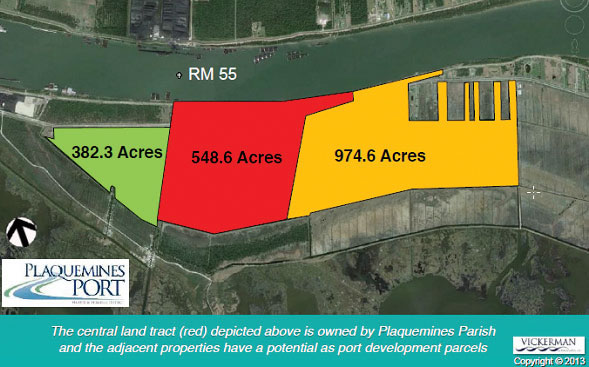Two proposed interconnected projects promise to boost containerized soybeans exports: A new intermodal container terminal on the lower Mississippi River and a unique type of inland vessels to carry the soybeans to the port from terminals up the river.
Both are in the planning stages, although the vessel project is much further along.
Plaquemines Port is a hugely ambitious effort that envisions a multi-billion-dollar LNG re-liquefaction facility, a $2.5 billion oil export terminal, a break bulk terminal, as well as a container terminal and intermodal facilities, including rail, truck and air links. The site is in Louisiana, near the Gulf, between miles 50 and 55 on the Mississippi River. It is being billed as a unique greenfield effort that can utilize the latest in technology, with land aplenty and no need to shoehorn facilities into an existing footprint. One advantage is that the container port can accommodate the largest container vessels out there. It will be situated at the widest and deepest part of the Mississippi, with a 55-foot draft.
The container port and associated intermodal connections won’t be operational for at least another three to four years minimum, and will need enormous amounts of capital from private equity and other sources.

The new ship project envisions self-propelled vessels that range in size from 592 feet to 952 feet, or 9,489 deadweight tons to 16,079 dwt. The larger “liner” vessel is capable of carrying up to 2,375 TEUs. It can travel at 13 miles an hour, with no wake, allowing the ship to make a round trip between Plaquemines and Memphis in seven days and Plaquemines and St. Louis in ten days.
A smaller “hybrid” vessel can carry up to 1,700 TEUs and is designed to transit the lock and dam portions of America’s inland waterways.
This project is the brainchild of American Patriot Holdings LLC, a marine consultancy and vessels owner and operations enterprise based in Miami. Joseph Gehegan, one of the three founders, provided an update to American Journal of Transportation. According to Gehegan, the initial vessel design passed prototype tests in Germany a year back. “The results were far better than we anticipated,” he said. His company has since fine-tuned the design of the vessel to “improve efficiency even more,” Gehegan said. The company hopes that further tests will be finished by the end of this month. After the American Bureau of Shipping approves the vessels in principle, American Patriot will finalize the specifications and will send out for bids, “probably the first quarter of next year,” Gehegan said. American Patriot will place an initial order for four vessels. “We can work up to as many as 10 or 12, depending on what the requirements are, Gehegan said. It will take 20 to 24 months to construct the first ship, with others to follow in three or four months.
“There’s nothing like this that has been built for the inland waterways,” said Gehegan. “This is a first of its kind.”
The vessel’s economic viability is tied to discharging at Plaquemines and American Patriot has an exclusivity agreement with the port authority for berths. However, American Patriot understands new port development would lag vessel construction. According to Gehegan, his company is now negotiating with Plaquemines on an interim facility that “can go into service to coincide with the timetable of the vessels,” as well as necessary ports upgrades upriver.
The vessels will require new facilities in St. Louis and Memphis as well, although these are far less ambitious and could be operational in two years. According to a study by Informa Economics IEG, commissioned by the Soy Transportation Coalition and the Illinois Soybean Association, a new container handling facility in a port like Memphis would run about $58 million, $30 million of which is the cost of a new crane.
A financial analysis made by Informa for the container study provides a compelling argument for these types of vessels. According to Informa, the cost per metric ton of containers shipped from St. Louis or Memphis by these vessels, then transshipped by container vessel to China total $105 to $109. The total cost from Little Rock, Jolliet or Kansas City to China is $108 to $116. That’s still more expensive than barge transport, which ranges from $76 to $97 per metric ton, depending on the port. However, it’s far cheaper than intermodal rail-ship transport, which ranges from $170 to over $200 per metric ton, the current preferred mode from many parts of the Midwest. And, it’s much faster than barges, which can only travel at 4 or 5 mph. The new vessels would cut travel time down by a full two weeks from barges, according to the Informa study.
“Lashing barges together and trying to use them to transport containers, the economics just don’t pencil out,” said Mike Steenhoek, executive director of the Soy Transportation Coalition. “They’re designed to carry bulk commodities.”
Of course, two-way traffic is necessary for the new vessel service to be profitable and that will necessitate something of a shift in where containers full of finished goods from Asia and Europe are discharged in the US.
“This whole model is predicated on containers full of consumer goods coming to these regions and these communities in the first place. That has to be an initial draw,” said Steenhoek. Agriculture, “is not the front-haul movement, we’re the backhaul movement. We can be a nice source of revenue for the ocean vessel companies, but their profitability isn’t going to rise or fall based on ag.”

Follow us on social media: